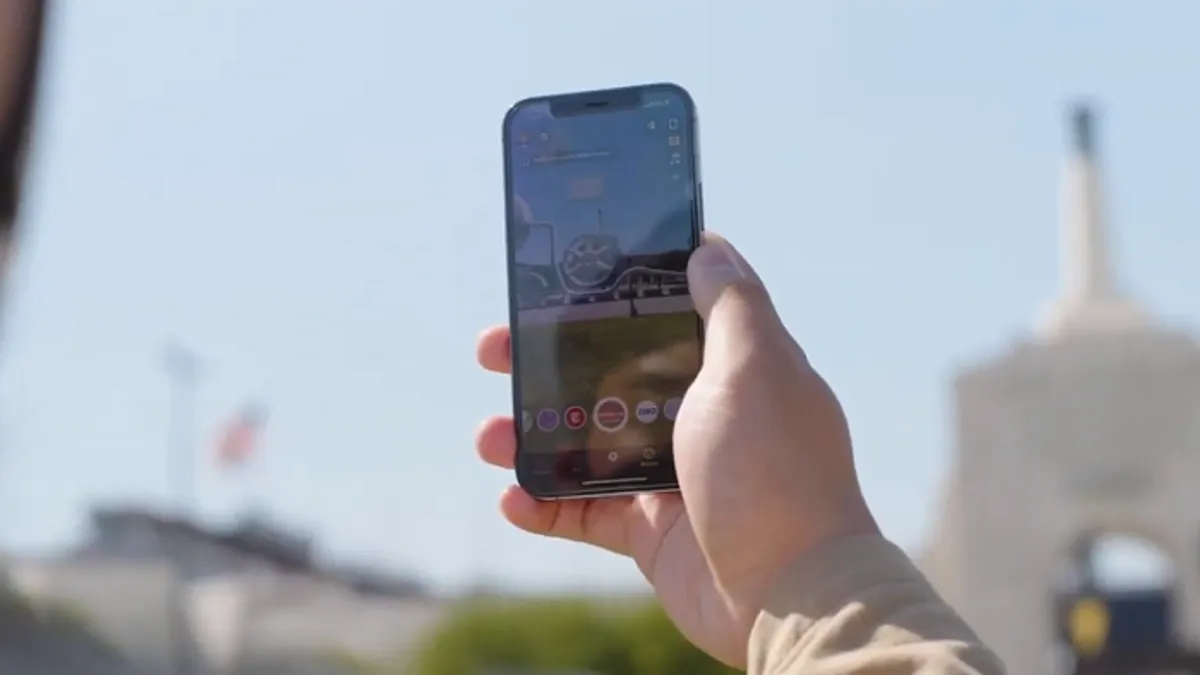The growing adoption of higher-speed 5G mobile service promises to provide marketers deeper ways of connecting with consumers through augmented reality (AR) experiences. The interactive content has a variety of applications for brands that seek to offer a more comprehensive view of their products and services remotely.
"A lot of brands have this concept that they have to get consumers to touch and feel a product, and get used to it," Jake Moskowitz, head of data strategy at Ericsson Emodo, the telecom equipment maker's mobile ad platform, said at the Mobile Marketing Association's Impact conference on April 7. "COVID has permanently changed that part of human life where we're used to going out to exploring and being in a physical space for a long period."
AR experiences let brands and retailers that previously relied on brick-and-mortar stores to showcase their wares in ways that reach a broader audience on mobile.
"We're seeing AR works up and down the funnel in our early tests... Those exposed to AR love AR."

Jake Moskowitz
Head of data strategy, Ericsson Emodo
"The same things that drove our brands to need that flagship store or need for consumers to touch and feel physically — you can accomplish many of the same things at much greater scale using augmented reality," Moskowitz said in the discussion about the intersection of AR and 5G with Scott Elchison, manager of partnerships at IPG Media Lab.
Emodo has seen positive results in AR-based campaigns, including one for a national convenience store chain whose return on ad spend (ROAS) was 3.79 times greater, as measured by data location company Placed. AR not only can bring consumers into the purchase funnel, but it also can help to bring them closer to the point of sale.
"We're seeing AR works up and down the funnel in our early tests," Moskowitz said. "Those exposed to AR love AR."
The advantage of immersive content is that it appeals to every consumer segment, Emodo found in a survey of 300 owners of 5G phones. Many of those owners don't consider themselves to be tech-savvy, with two-thirds of self-proclaimed "later adopters" asking for more AR ads over traditional formats. Sixty-one percent of survey respondents who said 5G wasn't a major driver in their phone choice also said AR ads grab their attention more than normal ads do, the survey found.
Popular applications for AR
The three most popular marketing applications for AR are product try-ons, demonstrations and mixed reality portals, per Moskowitz.
Product try-ons use the front-facing camera to show a mobile user with a virtual overlay of makeup or clothing. AR sampling is most popular in the beauty industry, with major brands including L'Oréal and Estée Lauder adopting the technology early on to help mobile shoppers visualize their products without having to visit stores.
Product demonstrations have included everything from technology to home furnishings, with companies like Ikea among the first adopters of AR. The company developed 3D models of its products that mobile users could virtually place in their real surroundings through a smartphone camera.
"If you have a physical product, and people want to see how it's going to fit into their life or their environment around them, that visualization is a great tool to provide some sort of tangibility in a traditionally 2D environment," Elchison said.
Mixed reality portals use a smartphone's rear camera to show a computer-generated doorway that's fixed in the user's surroundings. By walking forward through the portal, the AR experience gives the illusion of entering a completely virtual world that can be viewed at different angles. Luxury brand Gucci Beauty, store chain Kohl's and toy retailer Toys 'R' Us featured AR portals in their campaigns to immerse shoppers in a branded experience.
AR ad units
Moskowitz said Emodo is pushing digital ads that have embedded AR experiences instead of pointing consumers elsewhere, making the content more immediate and engaging.
"We're working to bring the AR experience into the ad itself so that we can provide far greater reach and scale," he said. "Advertising has fallen behind — AR has come a lot further and advertising has followed it, but that is changing right now."
Creating content for AR environments requires specialized knowledge, including expertise that's commonly found among designers of video games who work with 3D renditions of objects, Elchison said. In many cases, they may use software like Unity or Epic Games' Unreal Engine to create graphics for virtual environments.
"There is a whole new vocabulary that you need to learn to properly talk to game designers and game developers to make these assets," Elchison said. "It truly is a specialized skill to build out one of these experiences. It's very different from your traditional banner assets or video production."
In the longer term, AR experiences are set to become a more significant part of brands' ad creative, Elchison predicts.
"We're going to see a lot of our creative assets, our marketing materials — everything that is traditional in the whole marketing pipeline today when it comes to creative especially — is going to start to be optimized for 3D environments," he said.






















